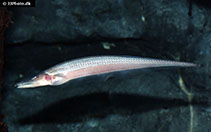| Family: |
Apteronotidae (Ghost knifefishes), subfamily: Apteronotinae |
| Max. size: |
22.6 cm SL (male/unsexed) |
| Environment: |
pelagic; freshwater |
| Distribution: |
South America: Brazil. Known from the western Amazon River basin of Peru and Brazil. Collection localities are in the Rio Amazonas, near Iquitos, Peru, the Rio Solimões below the confluence of the Rio Purus, Brazil, and the lower Rio Iça of Brazil. |
| Diagnosis: |
Compsaraia samueli differs unambiguously
from C. compsa by the presence of the following character states:more caudal-fin rays (17–18 [mode 18] vs. 13–16 [mode 14]); a shorter caudal peduncle (CP/LEA = 9% [0–23%] vs. 34% [18–46%]); a less tapering body shape in lateral profile, in which the ratio of body depth measurements at the anal fin and dorsal organ origins is greater (93% [80–116%] vs. 75% [67–82%]); and a smaller body size (minimum
size at sexual maturity 144 mm [vs. 165 mm], maximum total length of 230 mm [vs. 305 mm]). Compsaraia samueli may be further distinguished from C. compsa by secondary sexual dimorphisms in several features of snout and jaw morphology (Ref. 80384). |
| Biology: |
Electric organ discharge known from two sexually mature
females and three sexually mature males. The two female specimens exhibited a lower Fo (1.242–1.243 kHz) than the three male specimens (1.337, 1.387 and 1.396 kHz) (Ref. 80384). |
| IUCN Red List Status: |
Least Concern (LC); Date assessed: 21 July 2020 Ref. (130435)
|
| Threat to humans: |
harmless |
| Country info: |
|
Source and more info: www.fishbase.org. For personal, classroom, and other internal use only. Not for publication.

